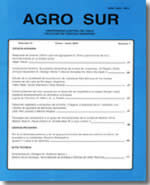CONTROL DEL DESARROLLO DE BACTERIAS ACIDO BUTIRICAS EN QUESO TIPO GOUDA EMPLEANDO DIFERENTES CONCENTRACIONES DE NITRATO Y TEMPERATURAS DE MADURACION
Contenido principal del artículo
Resumen
El presente trabajo tuvo por objetivo determinar el efecto de la temperatura de maduración y la concentración de nitrato sobre el desarrollo de las bacterias ácido butíricas (BAB) en queso tipo Gouda. Se elaboraron quesos con cuatro concentraciones de nitrato (0 %, 0,015 %, 0,020 % y 0,030 %), los cuales se almacenaron a tres temperaturas (4 °C, 10 °C y 16 °C), durante 6, 12 o 18 semanas. Para cada tiempo y temperatura de maduración se elaboraron tres quesos, en tres fechas diferentes. Se determinó el Número Más Probable (NMP) de bacterias ácido butíricas (BAB) utilizando la técnica de Fryer y Halligan modificada. Se encontró un bajo número inicial de esporas de BAB en la leche, sin embargo, a las seis semanas ya se observó el desarrollo de estas bacterias en los quesos sin nitrato. La maduración a 16 °C fue favorable para el crecimiento de BAB, obteniéndose en los tratamientos sin nitrato valores de NMP superiores a 1,100 /g, en cambio a las demás temperaturas solo en algunas muestras hubo desarrollo de BAB. El nitrato fue efectivo para inhibir el desarrollo de BAB, incluso a 16 °C, no encontrándose diferencias en el nivel de inhibición entre las tres concentraciones estudiadas. Esto probablemente se debió al bajo número inicial de esporas en la leche. La identificación de las BAB mostró una mayor presencia de C. tyrobutyricum que de C. butyricum y C. sporogenes. Se concluye que la maduración de queso tipo Gouda a ≤10 °C es una barrera efectiva para inhibir el crecimiento de BAB, incluso sin la adición de nitrato. A 16 °C las BAB también fueron inhibidas en presencia de nitrato, sin embargo hubo un desarrollo significativo en el tratamiento sin nitrato.

